Intercultural Business Communication: A Comparative Report Analysis
VerifiedAdded on 2021/12/21
|7
|1229
|22
Report
AI Summary
This report provides a comparative analysis of intercultural business communication, contrasting practices and perceptions between Western and Eastern cultures. It examines key aspects such as the concept of time, highlighting differences in punctuality and flexibility. The report explores the 'boss concept,' contrasting the Western team-oriented leadership with the more hierarchical structures often found in the East. It further delves into communication styles, including questioning approaches and handling challenges, emphasizing the directness of Western communication versus the indirectness and emphasis on relationships in Eastern cultures. The report also investigates workplace relationships, decision-making processes, and lifestyle differences, offering insights into how cultural nuances impact business interactions. The document concludes with a discussion on how newcomers are treated and self-portrayal, providing a comprehensive overview of the complexities of intercultural business communication.
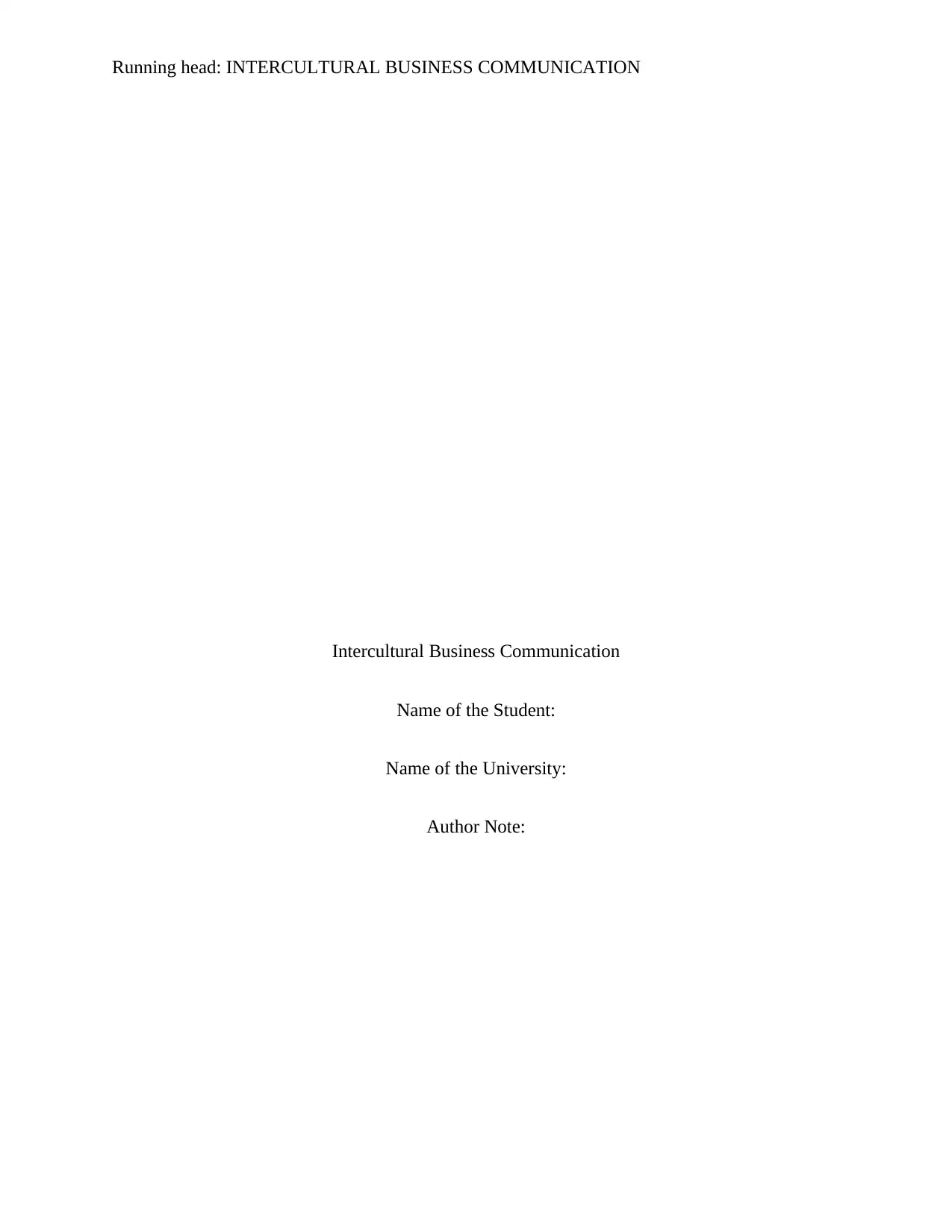
Running head: INTERCULTURAL BUSINESS COMMUNICATION
Intercultural Business Communication
Name of the Student:
Name of the University:
Author Note:
Intercultural Business Communication
Name of the Student:
Name of the University:
Author Note:
Secure Best Marks with AI Grader
Need help grading? Try our AI Grader for instant feedback on your assignments.
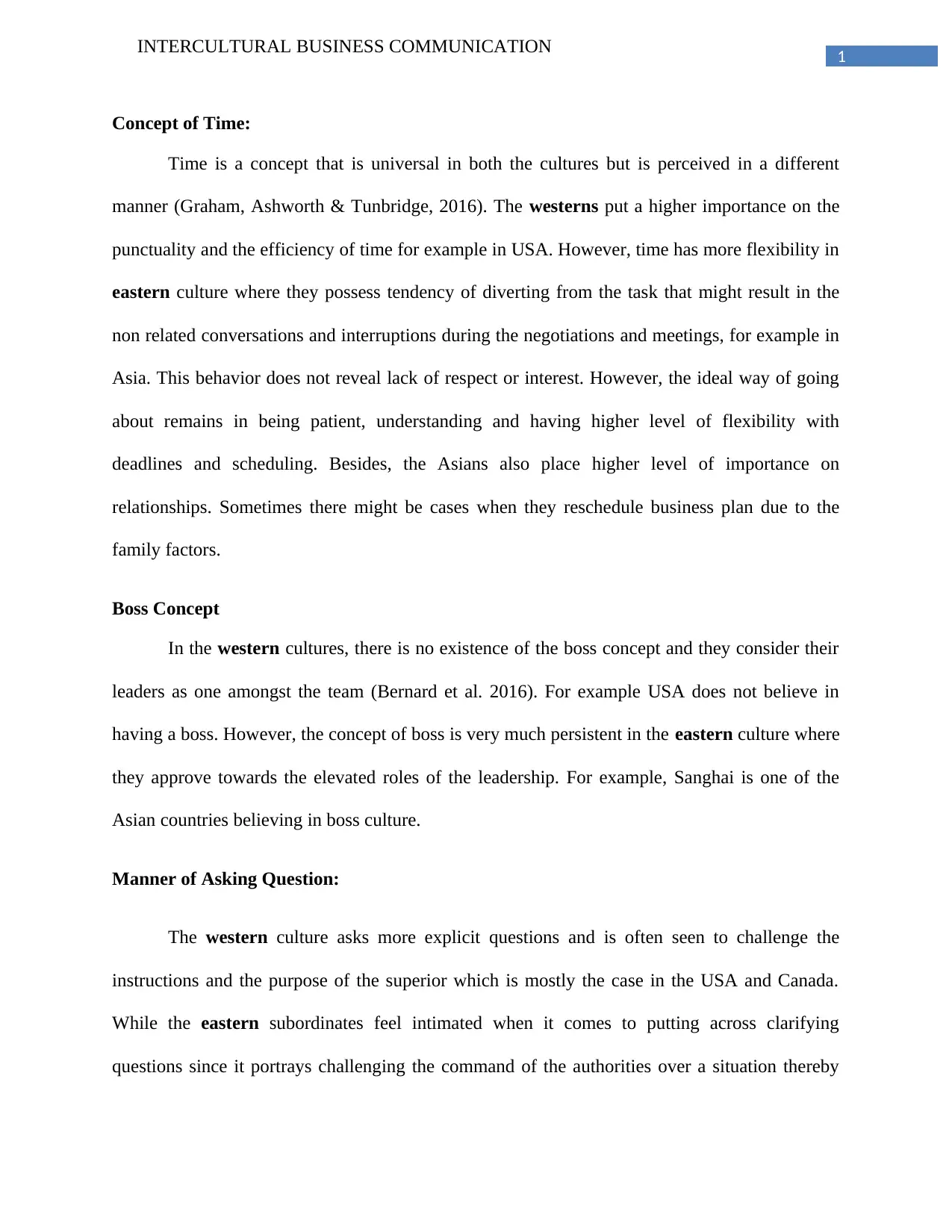
1
INTERCULTURAL BUSINESS COMMUNICATION
Concept of Time:
Time is a concept that is universal in both the cultures but is perceived in a different
manner (Graham, Ashworth & Tunbridge, 2016). The westerns put a higher importance on the
punctuality and the efficiency of time for example in USA. However, time has more flexibility in
eastern culture where they possess tendency of diverting from the task that might result in the
non related conversations and interruptions during the negotiations and meetings, for example in
Asia. This behavior does not reveal lack of respect or interest. However, the ideal way of going
about remains in being patient, understanding and having higher level of flexibility with
deadlines and scheduling. Besides, the Asians also place higher level of importance on
relationships. Sometimes there might be cases when they reschedule business plan due to the
family factors.
Boss Concept
In the western cultures, there is no existence of the boss concept and they consider their
leaders as one amongst the team (Bernard et al. 2016). For example USA does not believe in
having a boss. However, the concept of boss is very much persistent in the eastern culture where
they approve towards the elevated roles of the leadership. For example, Sanghai is one of the
Asian countries believing in boss culture.
Manner of Asking Question:
The western culture asks more explicit questions and is often seen to challenge the
instructions and the purpose of the superior which is mostly the case in the USA and Canada.
While the eastern subordinates feel intimated when it comes to putting across clarifying
questions since it portrays challenging the command of the authorities over a situation thereby
INTERCULTURAL BUSINESS COMMUNICATION
Concept of Time:
Time is a concept that is universal in both the cultures but is perceived in a different
manner (Graham, Ashworth & Tunbridge, 2016). The westerns put a higher importance on the
punctuality and the efficiency of time for example in USA. However, time has more flexibility in
eastern culture where they possess tendency of diverting from the task that might result in the
non related conversations and interruptions during the negotiations and meetings, for example in
Asia. This behavior does not reveal lack of respect or interest. However, the ideal way of going
about remains in being patient, understanding and having higher level of flexibility with
deadlines and scheduling. Besides, the Asians also place higher level of importance on
relationships. Sometimes there might be cases when they reschedule business plan due to the
family factors.
Boss Concept
In the western cultures, there is no existence of the boss concept and they consider their
leaders as one amongst the team (Bernard et al. 2016). For example USA does not believe in
having a boss. However, the concept of boss is very much persistent in the eastern culture where
they approve towards the elevated roles of the leadership. For example, Sanghai is one of the
Asian countries believing in boss culture.
Manner of Asking Question:
The western culture asks more explicit questions and is often seen to challenge the
instructions and the purpose of the superior which is mostly the case in the USA and Canada.
While the eastern subordinates feel intimated when it comes to putting across clarifying
questions since it portrays challenging the command of the authorities over a situation thereby
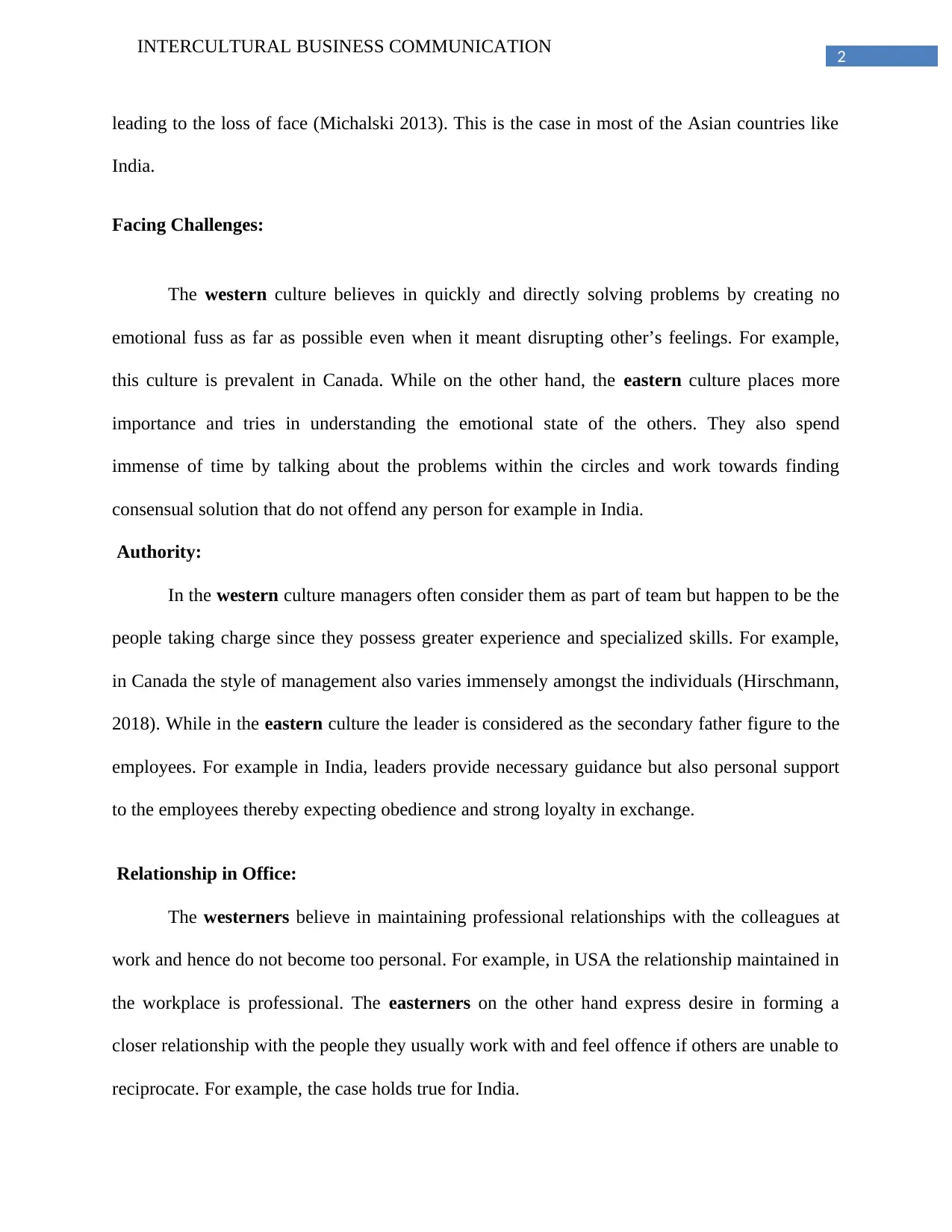
2
INTERCULTURAL BUSINESS COMMUNICATION
leading to the loss of face (Michalski 2013). This is the case in most of the Asian countries like
India.
Facing Challenges:
The western culture believes in quickly and directly solving problems by creating no
emotional fuss as far as possible even when it meant disrupting other’s feelings. For example,
this culture is prevalent in Canada. While on the other hand, the eastern culture places more
importance and tries in understanding the emotional state of the others. They also spend
immense of time by talking about the problems within the circles and work towards finding
consensual solution that do not offend any person for example in India.
Authority:
In the western culture managers often consider them as part of team but happen to be the
people taking charge since they possess greater experience and specialized skills. For example,
in Canada the style of management also varies immensely amongst the individuals (Hirschmann,
2018). While in the eastern culture the leader is considered as the secondary father figure to the
employees. For example in India, leaders provide necessary guidance but also personal support
to the employees thereby expecting obedience and strong loyalty in exchange.
Relationship in Office:
The westerners believe in maintaining professional relationships with the colleagues at
work and hence do not become too personal. For example, in USA the relationship maintained in
the workplace is professional. The easterners on the other hand express desire in forming a
closer relationship with the people they usually work with and feel offence if others are unable to
reciprocate. For example, the case holds true for India.
INTERCULTURAL BUSINESS COMMUNICATION
leading to the loss of face (Michalski 2013). This is the case in most of the Asian countries like
India.
Facing Challenges:
The western culture believes in quickly and directly solving problems by creating no
emotional fuss as far as possible even when it meant disrupting other’s feelings. For example,
this culture is prevalent in Canada. While on the other hand, the eastern culture places more
importance and tries in understanding the emotional state of the others. They also spend
immense of time by talking about the problems within the circles and work towards finding
consensual solution that do not offend any person for example in India.
Authority:
In the western culture managers often consider them as part of team but happen to be the
people taking charge since they possess greater experience and specialized skills. For example,
in Canada the style of management also varies immensely amongst the individuals (Hirschmann,
2018). While in the eastern culture the leader is considered as the secondary father figure to the
employees. For example in India, leaders provide necessary guidance but also personal support
to the employees thereby expecting obedience and strong loyalty in exchange.
Relationship in Office:
The westerners believe in maintaining professional relationships with the colleagues at
work and hence do not become too personal. For example, in USA the relationship maintained in
the workplace is professional. The easterners on the other hand express desire in forming a
closer relationship with the people they usually work with and feel offence if others are unable to
reciprocate. For example, the case holds true for India.
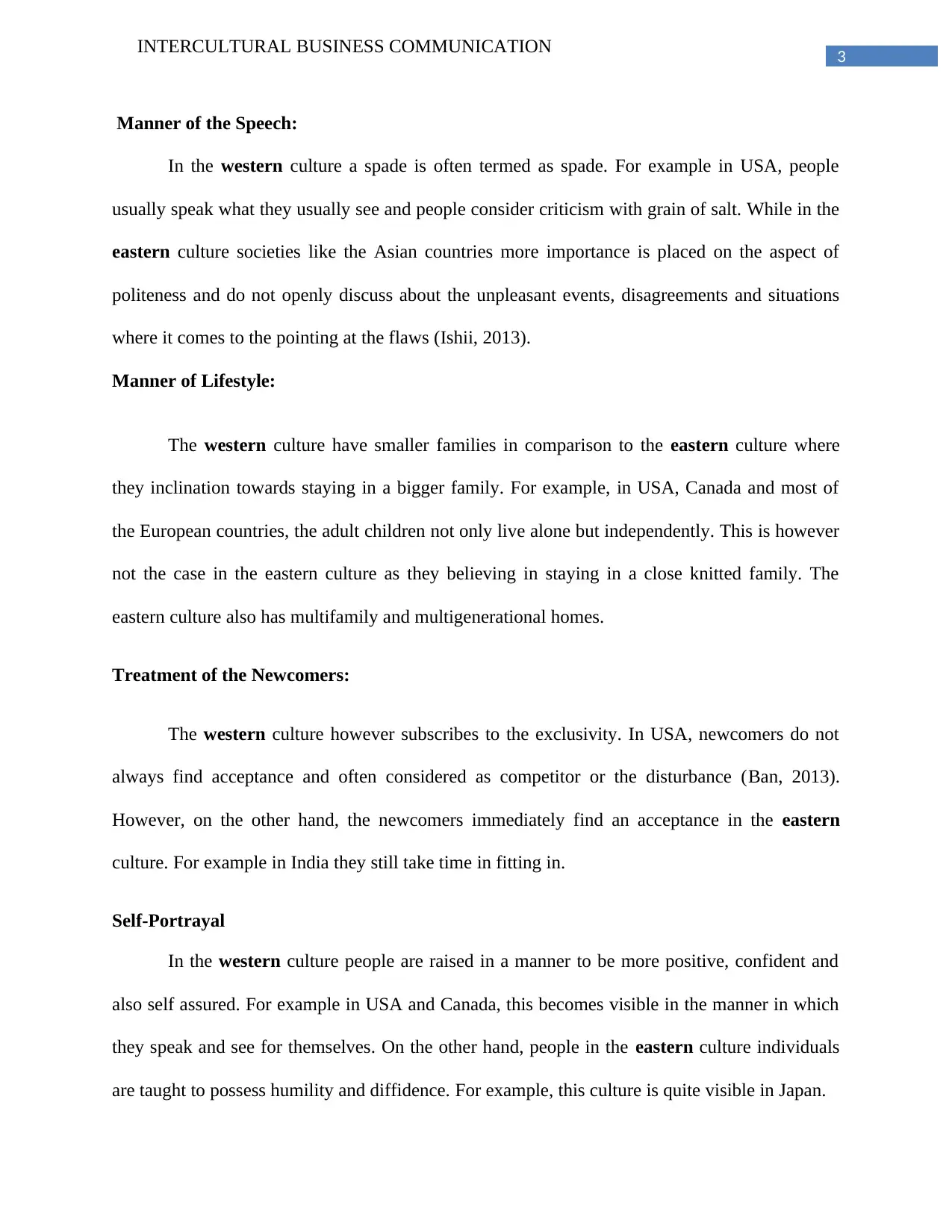
3
INTERCULTURAL BUSINESS COMMUNICATION
Manner of the Speech:
In the western culture a spade is often termed as spade. For example in USA, people
usually speak what they usually see and people consider criticism with grain of salt. While in the
eastern culture societies like the Asian countries more importance is placed on the aspect of
politeness and do not openly discuss about the unpleasant events, disagreements and situations
where it comes to the pointing at the flaws (Ishii, 2013).
Manner of Lifestyle:
The western culture have smaller families in comparison to the eastern culture where
they inclination towards staying in a bigger family. For example, in USA, Canada and most of
the European countries, the adult children not only live alone but independently. This is however
not the case in the eastern culture as they believing in staying in a close knitted family. The
eastern culture also has multifamily and multigenerational homes.
Treatment of the Newcomers:
The western culture however subscribes to the exclusivity. In USA, newcomers do not
always find acceptance and often considered as competitor or the disturbance (Ban, 2013).
However, on the other hand, the newcomers immediately find an acceptance in the eastern
culture. For example in India they still take time in fitting in.
Self-Portrayal
In the western culture people are raised in a manner to be more positive, confident and
also self assured. For example in USA and Canada, this becomes visible in the manner in which
they speak and see for themselves. On the other hand, people in the eastern culture individuals
are taught to possess humility and diffidence. For example, this culture is quite visible in Japan.
INTERCULTURAL BUSINESS COMMUNICATION
Manner of the Speech:
In the western culture a spade is often termed as spade. For example in USA, people
usually speak what they usually see and people consider criticism with grain of salt. While in the
eastern culture societies like the Asian countries more importance is placed on the aspect of
politeness and do not openly discuss about the unpleasant events, disagreements and situations
where it comes to the pointing at the flaws (Ishii, 2013).
Manner of Lifestyle:
The western culture have smaller families in comparison to the eastern culture where
they inclination towards staying in a bigger family. For example, in USA, Canada and most of
the European countries, the adult children not only live alone but independently. This is however
not the case in the eastern culture as they believing in staying in a close knitted family. The
eastern culture also has multifamily and multigenerational homes.
Treatment of the Newcomers:
The western culture however subscribes to the exclusivity. In USA, newcomers do not
always find acceptance and often considered as competitor or the disturbance (Ban, 2013).
However, on the other hand, the newcomers immediately find an acceptance in the eastern
culture. For example in India they still take time in fitting in.
Self-Portrayal
In the western culture people are raised in a manner to be more positive, confident and
also self assured. For example in USA and Canada, this becomes visible in the manner in which
they speak and see for themselves. On the other hand, people in the eastern culture individuals
are taught to possess humility and diffidence. For example, this culture is quite visible in Japan.
Secure Best Marks with AI Grader
Need help grading? Try our AI Grader for instant feedback on your assignments.
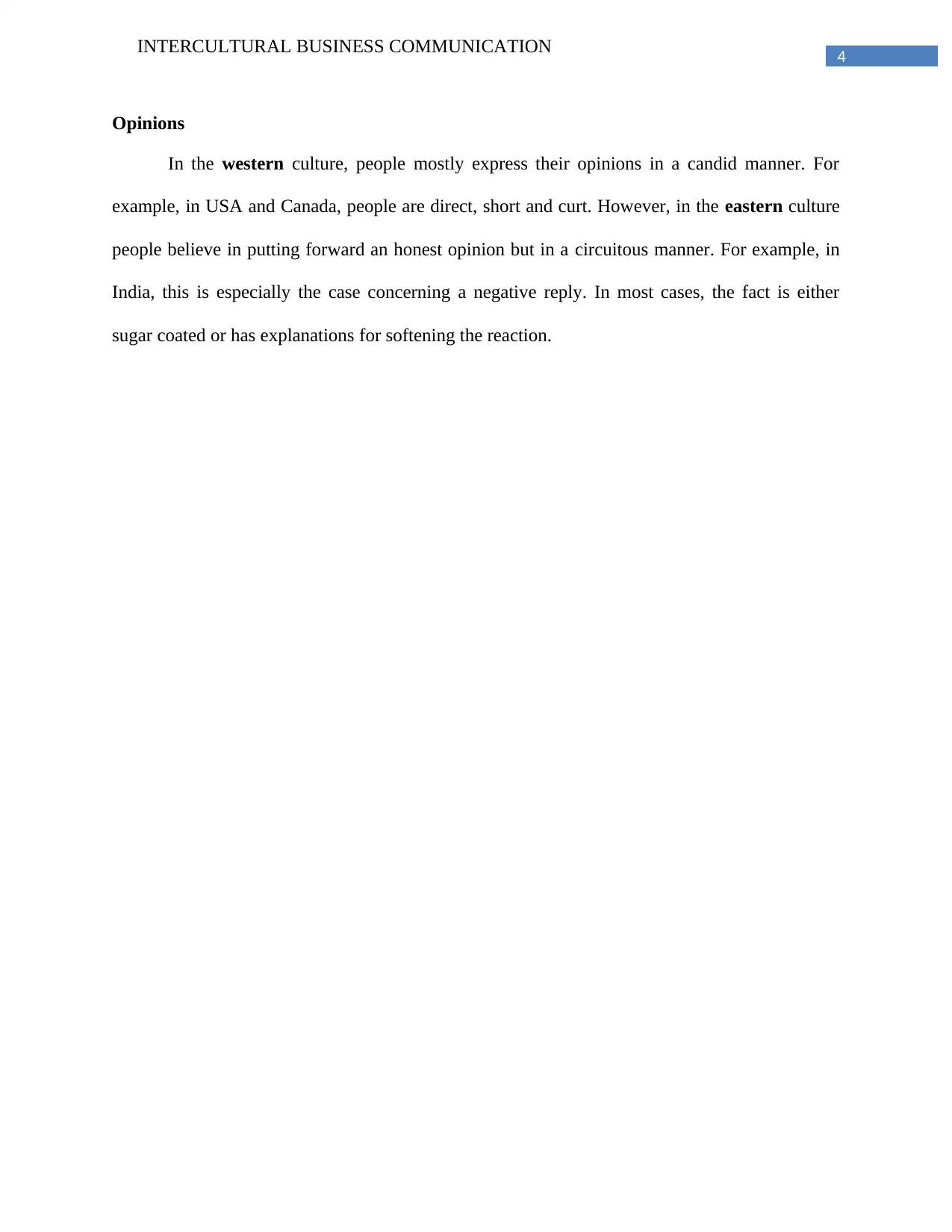
4
INTERCULTURAL BUSINESS COMMUNICATION
Opinions
In the western culture, people mostly express their opinions in a candid manner. For
example, in USA and Canada, people are direct, short and curt. However, in the eastern culture
people believe in putting forward an honest opinion but in a circuitous manner. For example, in
India, this is especially the case concerning a negative reply. In most cases, the fact is either
sugar coated or has explanations for softening the reaction.
INTERCULTURAL BUSINESS COMMUNICATION
Opinions
In the western culture, people mostly express their opinions in a candid manner. For
example, in USA and Canada, people are direct, short and curt. However, in the eastern culture
people believe in putting forward an honest opinion but in a circuitous manner. For example, in
India, this is especially the case concerning a negative reply. In most cases, the fact is either
sugar coated or has explanations for softening the reaction.
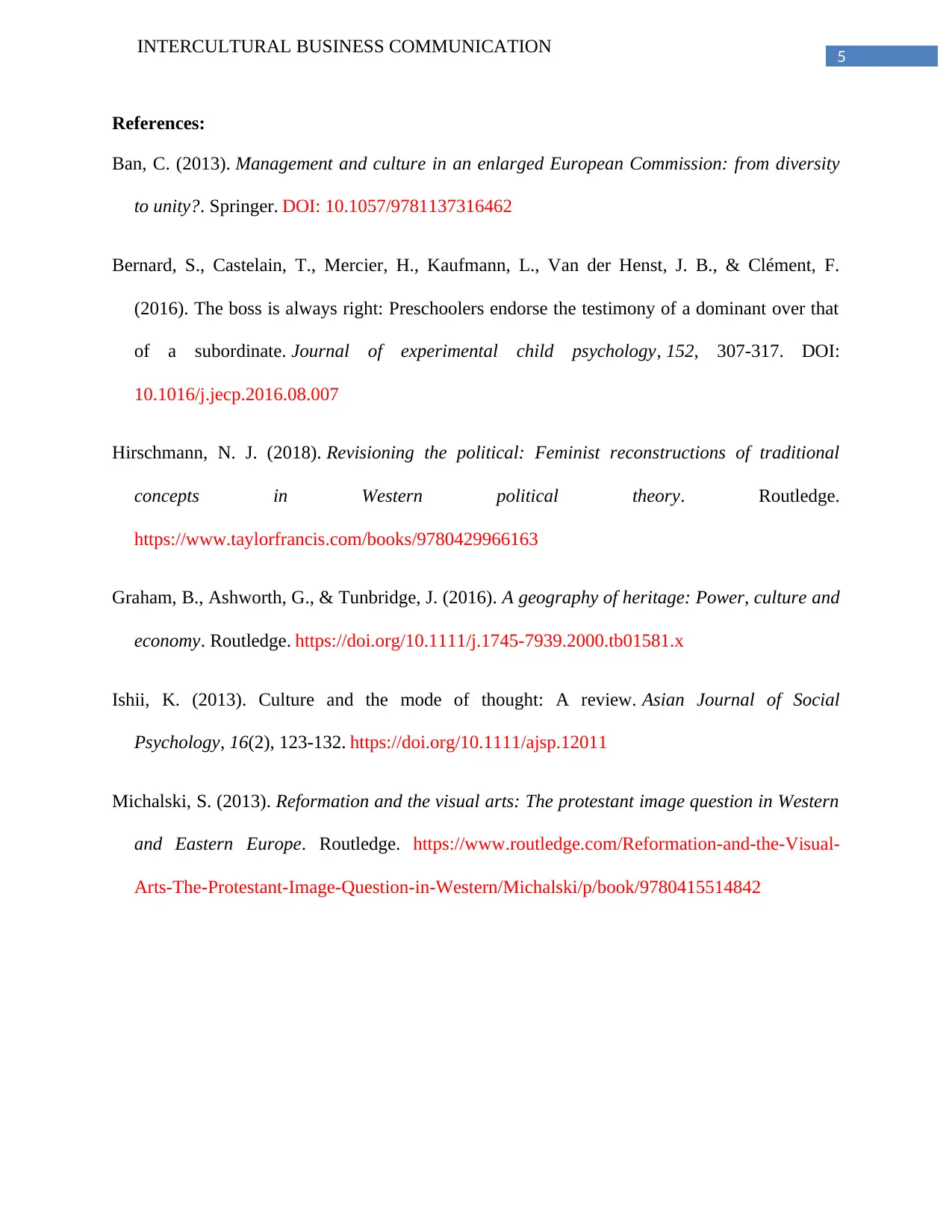
5
INTERCULTURAL BUSINESS COMMUNICATION
References:
Ban, C. (2013). Management and culture in an enlarged European Commission: from diversity
to unity?. Springer. DOI: 10.1057/9781137316462
Bernard, S., Castelain, T., Mercier, H., Kaufmann, L., Van der Henst, J. B., & Clément, F.
(2016). The boss is always right: Preschoolers endorse the testimony of a dominant over that
of a subordinate. Journal of experimental child psychology, 152, 307-317. DOI:
10.1016/j.jecp.2016.08.007
Hirschmann, N. J. (2018). Revisioning the political: Feminist reconstructions of traditional
concepts in Western political theory. Routledge.
https://www.taylorfrancis.com/books/9780429966163
Graham, B., Ashworth, G., & Tunbridge, J. (2016). A geography of heritage: Power, culture and
economy. Routledge. https://doi.org/10.1111/j.1745-7939.2000.tb01581.x
Ishii, K. (2013). Culture and the mode of thought: A review. Asian Journal of Social
Psychology, 16(2), 123-132. https://doi.org/10.1111/ajsp.12011
Michalski, S. (2013). Reformation and the visual arts: The protestant image question in Western
and Eastern Europe. Routledge. https://www.routledge.com/Reformation-and-the-Visual-
Arts-The-Protestant-Image-Question-in-Western/Michalski/p/book/9780415514842
INTERCULTURAL BUSINESS COMMUNICATION
References:
Ban, C. (2013). Management and culture in an enlarged European Commission: from diversity
to unity?. Springer. DOI: 10.1057/9781137316462
Bernard, S., Castelain, T., Mercier, H., Kaufmann, L., Van der Henst, J. B., & Clément, F.
(2016). The boss is always right: Preschoolers endorse the testimony of a dominant over that
of a subordinate. Journal of experimental child psychology, 152, 307-317. DOI:
10.1016/j.jecp.2016.08.007
Hirschmann, N. J. (2018). Revisioning the political: Feminist reconstructions of traditional
concepts in Western political theory. Routledge.
https://www.taylorfrancis.com/books/9780429966163
Graham, B., Ashworth, G., & Tunbridge, J. (2016). A geography of heritage: Power, culture and
economy. Routledge. https://doi.org/10.1111/j.1745-7939.2000.tb01581.x
Ishii, K. (2013). Culture and the mode of thought: A review. Asian Journal of Social
Psychology, 16(2), 123-132. https://doi.org/10.1111/ajsp.12011
Michalski, S. (2013). Reformation and the visual arts: The protestant image question in Western
and Eastern Europe. Routledge. https://www.routledge.com/Reformation-and-the-Visual-
Arts-The-Protestant-Image-Question-in-Western/Michalski/p/book/9780415514842

6
INTERCULTURAL BUSINESS COMMUNICATION
INTERCULTURAL BUSINESS COMMUNICATION
1 out of 7
Your All-in-One AI-Powered Toolkit for Academic Success.
+13062052269
info@desklib.com
Available 24*7 on WhatsApp / Email
![[object Object]](/_next/static/media/star-bottom.7253800d.svg)
Unlock your academic potential
© 2024 | Zucol Services PVT LTD | All rights reserved.